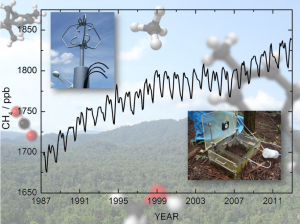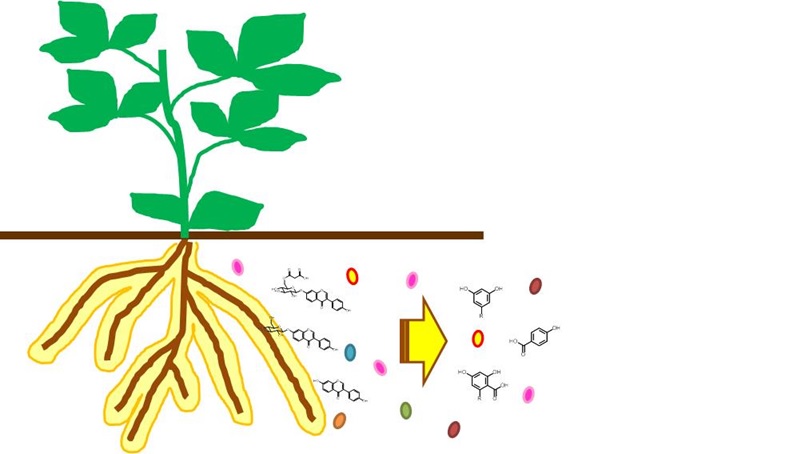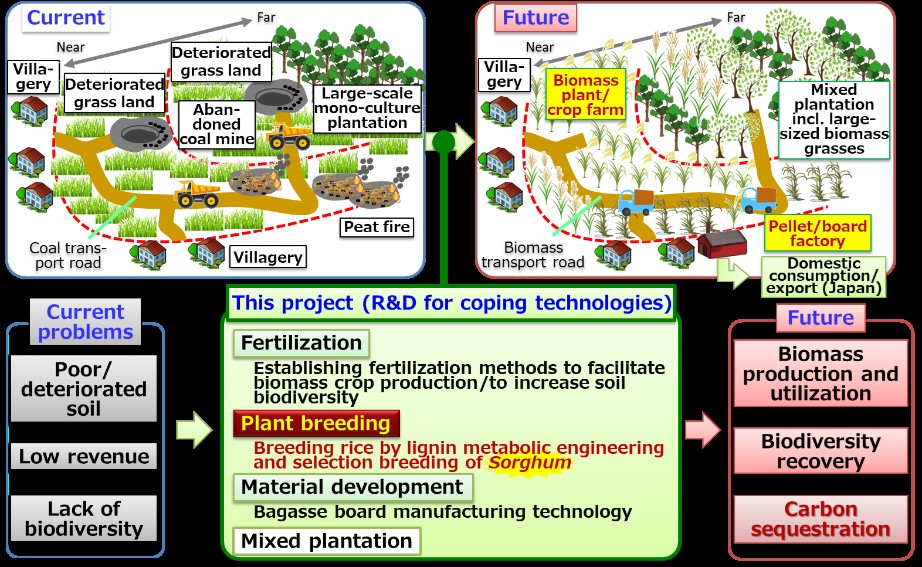2019 Activity Report for Mission 1: Environmental Diagnosis and Regulation of Circulatory Function
Updated: 2020/05/15
Research1:Biosphere−Atmosphere Exchange of Trace Molecules
Principal Investigator (PI): K. Takahashi (RISH, Kyoto University)
Research collaborator(s): Y. Kosugi (Graduate School of Agriculture, Kyoto University), A. Sakabe (Osaka Pref. Univ.), M. Itoh (Univ. Hyogo), H. Iwata (Shinshu Univ.)
We study carbon dynamics from the ecosystem scale to the plot scale in forest environments through in-situ measurements of trace gas fluxes based on micrometeorological methods and automated closed-chamber techniques.
Publication
- K. Takahashi, A. Sakabe, M. Itoh, W. Azuma, M. Tateishi, M. Ataka, and Y. Kosugi, Methane emission from woody stem and its potential impact on atmospheric methane budget, iLEAPS/IGAC-Japan Joint Workshop 2019, Sept. 6-7. 2019, Nagoya, Japan.
Research 2 :Analysis of plant metabolites in the rhizosphere
Principal Investigator (PI): Akifumi Sugiyama (RISH, Kyoto University)
Research collaborator(s): Shoichiro Hamamoto (Graduate School of Agriculture and Life Sciences, The University of Tokyo), Naoto Nihei (Graduate School of Agriculture and Life Sciences, The University of Tokyo)
The aim of this research is to elucidate the molecular mechanism of plant microbe interaction in the rhizosphere. We analyze transporter genes and metabolites which are involved in the plant microbe interactions. This year we revealed that daidzein shapes the soybean rhizosphere bacterial communities.
Figure. Secretion of isoflavones into the rhizosphere of soybean
Publication
- Okutani F., Hamamoto S., Aoki Y., Nakayasu M., Nihei N., Nishimura T., Yazaki K., Sugiyama A. (2020) Rhizosphere modelling reveals spatiotemporal distribution of daidzein shaping soybean rhizosphere bacterial community. Plant, Cell & Environment 43(4), 1036-1046.
Research 3: MU radar imaging observations of atmospheric structure in the troposphere
Principal Investigator (PI): Hiroyuki Hashiguchi (RISH, Kyoto University)
Research collaborators: Lakshmi Kantha・Abhiram Doddi(University of Colorado, USA)、Hubert Luce(Université de Toulon, France)
Range imaging was implemented in the MU radar observations during the Shigaraki UAV Radar Experiment (ShUREX) campaigns in the spring/summers of 2015, 2016, and 2017. The Capon backscatter images revealed a variety of atmospheric structures in the moist troposphere in details. Figure shows the time-height cross-section of echo intensities obtained by the MU radar range imaging. It can be seen that Kelvin-Helmholtz (KH) billows exist at an altitude of about 5 km in 14:30-14:50.
Time-height cross-section of echo intensities obtained by the MU radar [Kantha et al., 2019]
Publications
- L. Kantha, H. Luce, H. Hashiguchi, and A. Doddi, Atmospheric structures in the troposphere as revealed by high-resolution backscatter images from MU radar operating in range-imaging mode, Progress in Earth and Planetary Science, 6:32, doi:10.1186/s40645-019-0274-1, 2019.
Research 4: Alteration of cell shape in primary tissue during gravitropism
Principal Investigator (PI): Kei’ichi Baba (RISH, Kyoto University)
Research collaborators: Takako Doi (Unit of Synergetic Studies for Space, Kyoto University), Shoko Tsuji (Center for Ecological Research, Kyoto University), Nanako Matsunaga (RISH, Kyoto University), Hiroyuki Watanabe (Faculty of Agriculture, Tamagawa University)
Primary tissue of a stem in higher plants locates just below the apical meristem and bends to the opposite direction of the gravity vector. This phenomenon is called gravitropism. It is thought that differential growth results the stem bending, but it is not clear what stage gravitropism occurs on. Inflorescence stems of Arabidopsis thaliana were inclined and the actual bending zone was determined by marking and using image analyzing software. The cell shapes of epidermis before and after gravitropism were compared and the cells in bending tissue showed different alteration of the shape from those in elongating tissue.
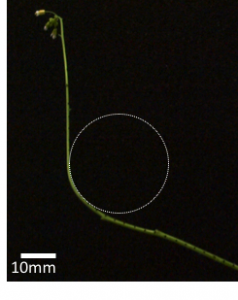 The radius and the peak of curvature in the gravitropic response by fitting an inscribed circle.
The radius and the peak of curvature in the gravitropic response by fitting an inscribed circle.
Publications, etc.
- The 33rd Annual Meeting of the Japanese Society for Biological Sciences in Space, Chiba, Japan, Sep 21-22, 2019.
Research 5:Collaborative studies in Fukushima since the Great East Japan Earthquake
Principal Investigator (PI): Yoshikatsu Ueda (RISH, Kyoto University)
Research collaborator(s): Akifumi Sugiyama (RISH, Kyoto University), Shiro Suzuki (RISH, Kyoto University),Naoto Nihei (Graduate School of Agricultural and Life Sciences, The University of Tokyo, Rattanaporn Norarat (Rajamangala University of Technology Lanna, Chiang Rai, Thailand), Minoru Tanigaki (Institute for Integrated Radiation and Nuclear Science, Kyoto University)
Radioactive Cesium fell down to cultivation area around Fukushima prefecture by the accident of Fukushima Daiichi Nuclear Power Plant on 2011. We conducted various methods to clean up soil for agriculture. We investigate the contamination variation around cultivation area by using the walking radiation measurement system KURAMA (Kyoto University RAdiation MApping system) and by direct measuring of radioactive cesium concentration as international collaboration.
 Visualizing environmental radiation map via KURAMA (Kyoto University RAdiation MApping system) and direct msurering of Cs-137 concentration
Visualizing environmental radiation map via KURAMA (Kyoto University RAdiation MApping system) and direct msurering of Cs-137 concentration
Publications, etc.
- R. Norarat, V. Thonglek, Y. Ueda, Ultrafine bubbles (UFB) stability and its filtering effect, International Journal of Plasma Environmental Science and Technology, vol. 14, accepted
- Ueda, Y., Nihei, N., Tanigaki, M., Norarat, R., Radioactive Cesium Distribution Measurement by Using KURAMA in Iitate Village, Fukushima, the International Workshop on Environmental Engineering 2019, Okinawa, 2019.6.27
Research 6: Observations of atmospheric minor constituents using lidar techniques
Principal Investigator (PI): Masanori Yabuki (RISH, Kyoto University)
Atmospheric lidar is a powerful tool for monitoring atmospheric constituents, which are key parameters for understanding the mechanisms underlying environmental changes and localized extreme weather events. In FY2019, a rotational Raman lidar was developed for observing temperature profiles. We have conducted a preliminary experiment using fluorescence lidar for detecting bio-aerosols and plants.
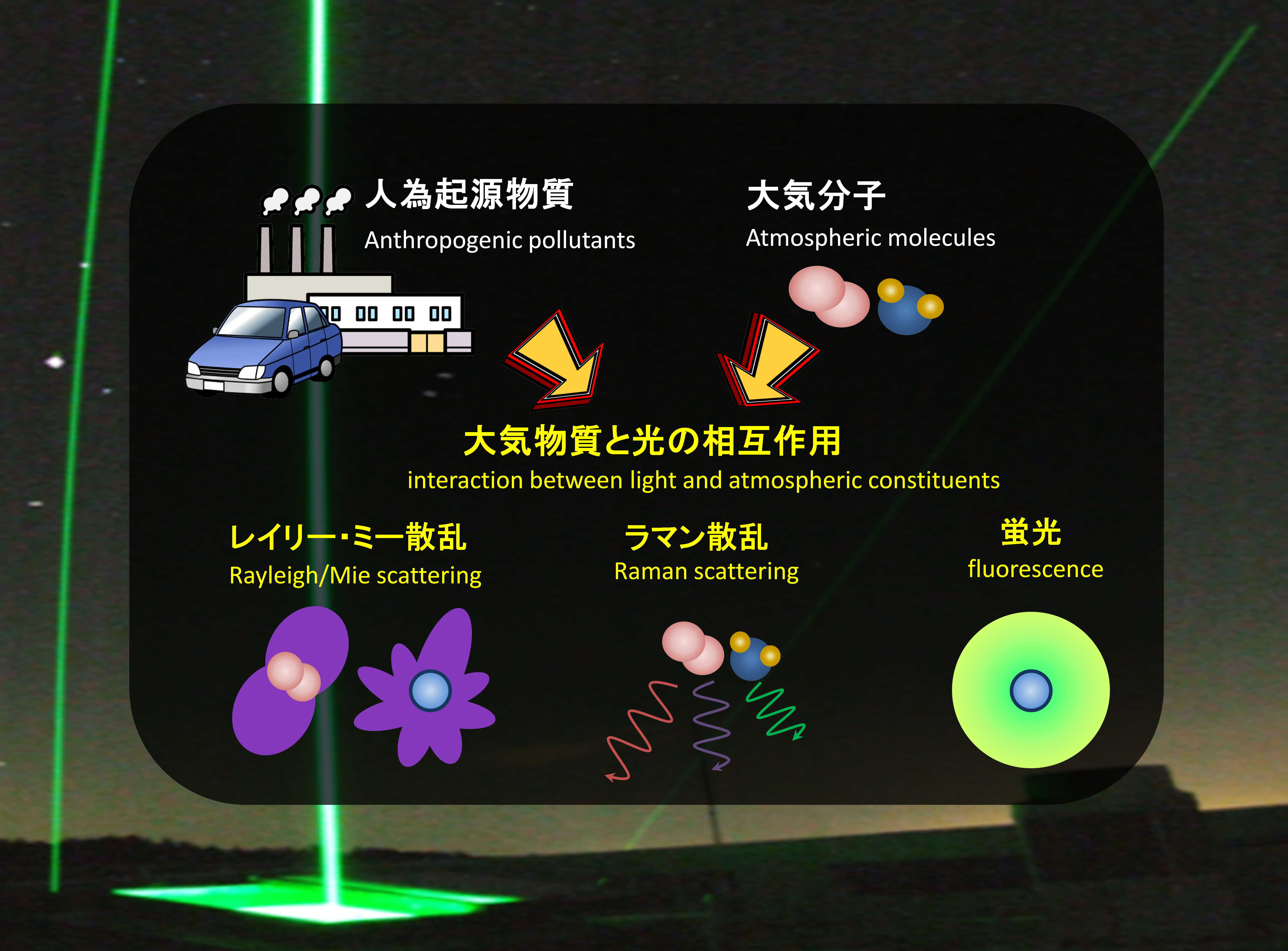
Publication
- Yabuki, M., Y. Kawano, Y. Tottori, M. Tsukamoto, E. Takeuchi, T. Hasegawa, and T. Tsuda, A Raman lidar with a deep ultraviolet laser for continuous water vapor profiling in the atmospheric boundary layer , The 29th International Laser Radar Conference (ILRC29)(Hefei, China,) June 24-28, 2019.
Research 7:Breeding of gramineous plants toward revegetation of deteriorated grass field and production of biomass energy
Principal Investigator (PI): Toshiaki Umezawa (RISH, Kyoto University)
Research collaborator(s): Yuki Tobimatsu, Takuji Miyamoto, Rie Takada, Yuri Takeda, Masaomi Yamamura, Shiro Suzuki (RISH, Kyoto University), Kosuke Mizuno (CSEAS, Kyoto University), Satoshi Konishi (IAE, Kyoto University), Masahiro Sakamoto (GSA, Kyoto University), Satya Nugroho (LIPI), Safendrri Komara Ragamustari (School of Government & Public Policy, Indonesia)
Appropriate management and revegetation of deteriorated grasslands formed after natural forest logging in Southeast Asia are global issues. In order to address this issue, we have been conducting researches aimed at revegetation of deteriorated grasslands and production of biomass energy. In this fiscal year, as a new development of the above research project, we are conducting the breeding of biomass plants suitable for carbon sequestration combining photovoltaic power generation and biomass production. In particular, we are promoting the breeding of high-productivity grass biomass plants with high carbon content.
Publications, etc.
- OsMYB108 loss-of-function enriches p-coumaroylated and tricin lignin units in rice cell walls, T. Miyamoto, R. Takada, Y. Tobimatsu, Y. Takeda, S. Suzuki, M. Yamamura, K. Osakabe, Y. Osakabe, M. Sakamoto, T. Umezawa, Plant J., 98, 975-987 (2019)
- Altered lignocellulose chemical structure and molecular assembly in CINNAMYL ALCOHOL DEHYDROGENASE-deficient rice, A. F. Martin, Y. Tobimatsu, R. Kusumi, N. Matsumoto, T. Miyamoto, P. Y. Lam, M. Yamamura, T. Koshiba, M. Sakamoto, T. Umezawa Sci Rep., 9, 17153 (2019)
Research 8: The research on insect – microbe – plant interactions
Principal Investigator (PI): Aya YANAGAWA (RISH, Kyoto University)
To study about the insect – microbe – plant interactions in agro-ecosystem, plant growth test has been started. Entomopathogenic fungus was added to soil. We will investigate its influence on plant growth or microbial activities.
Entomopathogen was incubated on brown rice and added into soil for a plant growth test in the model of organic farming.


